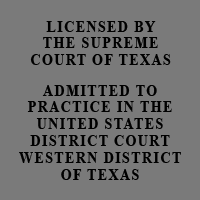Texas Multimedia Litigation Article
The Use of Technology & Multimedia in Litigation: Video, Photos, and Graphics Bring Facts to Life
|
BY JASON COOMER, Willie Buehler, AND Michele
Mckeever
|
||
|
|
"Man's
mind, once stretched by a new idea, never regains
its original dimension." -- Oliver Wendell Holmes In today's modern world, we are receiving information at a much faster pace than at any other time in history. More and more information comes at us every day through technology such as computers, cell phones, cable television, and video. We are able to process much of this increased information because many time it combines auditory with visual components giving us multiple perceptions of the same message. Studies have shown that people pay closer attention and more information is retained if the information comes through more than one sense such as both auditory and visual. In fact, that is how many of us now prefer to receive most of our information. Where it was once common and interesting to just listen to a radio show or to listen to someone orally give a speech, these modes of communication just don’t keep our attention anymore. We are used to hearing and seeing much more. In litigation, Judges, Jurors, Mediators, and
Arbitrators are typically the same. They
respond positively to seeing video, photos, time
lines, graphics, and other multimedia along with an
oral presentation of a case, instead of receiving an
oral narrative of the same facts. It gives them a
much better understanding of what happened and why
they should rule for one side or another. It
also can bring the facts of a case to life. Further, most people including judges and juries are used to receiving new stories via television with auditory and visual messages as to what has happened. Many of my clients think things are true just because they saw it on television. As such, converting your case to presentations and combining visual messages to your case, can often add credibility to your case. As a Texas litigation lawyer, I have used
multimedia effectively in a variety of litigation
claims including commercial real estate, automobile
accident, residential fire, toxic exposure, wrongful
death, and intellectual property claims to convey my
clients' cases. It has had a significant impact on
my cases, and typically puts pressure on the other
side to use multimedia in presenting their case.
When the other side fails to use any multimedia the
difference is obvious. Typically, it is evident
through the faces of the jurors, judge, arbitrator,
mediator, and the clients. Without a
presentation, they have a shorter attention span.
With a presentation, clients believe that their
cases are being handled well. Jason Coomer is an Austin lawyer
works with other attorneys on complex litigation
claims including large fires, commercial business to
business disputes, toxic torts, catastrophic injury
& death claims, probate matters, and technology
litigation. |
|
Austin Multimedia Litigation Lawyer Jason Coomer provides complex litigation claims including business litigation, catastrophic injury, mass tort, and wrongful death injury litigation. For questions on this article, hiring a multimedia litigation team, or legal services, please e-mail Austin lawyer Jason S. Coomer at multimedialitigation@texaslawyers.com.
The Law Offices of Jason S.
Coomer, PLLC
3901 S. Lamar Blvd., Ste. 260
Austin, Texas 78704
(512) 474-1477
jason@texaslawyers.com
Feel Free to Contact Us with any Questions
Associations




